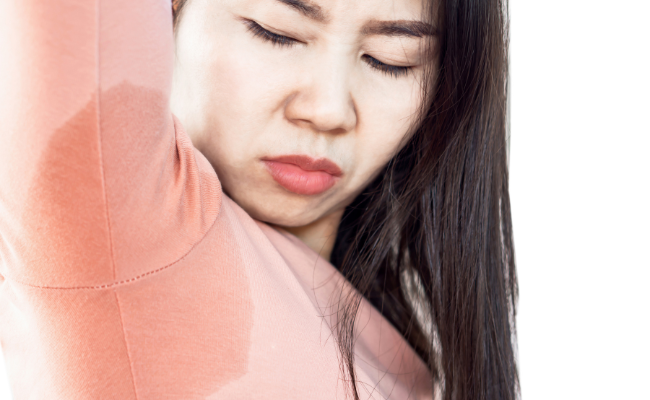How to Treat Hyperhidrosis - Excessive Sweating?
- February 07, 2024
- No Comments

What is Hyperhidrosis - Excessive Sweating?
Hyperhidrosis, also known as excessive sweating, is a condition characterized by the body producing more sweat than necessary for regulating temperature. This phenomenon occurs when sweat glands become overactive, leading to sweating even when the body is at rest or in situations where sweating is unexpected. Sweat, produced by eccrine glands in the skin, serves to regulate body temperature by evaporating from the skin's surface. However, in cases of hyperhidrosis, the sweat glands work excessively, resulting in persistent and often uncontrollable sweating. This condition can affect various parts of the body, including the armpits, palms, soles of the feet, and face, causing discomfort, embarrassment, and social anxiety for those affected.
Why is Treating Hyperhidrosis Important?
Treating hyperhidrosis is essential for several reasons. Firstly, excessive sweating can cause discomfort and embarrassment, leading to decreased self-confidence and social withdrawal. Additionally, prolonged exposure to sweat can contribute to skin irritation, fungal infections, and unpleasant body odor. By addressing hyperhidrosis, individuals can improve their quality of life, enhance their self-esteem, and prevent associated complications.
How to Treat Hyperhidrosis - Excessive Sweating?
- Topical Antiperspirants: Over-the-counter or prescription-strength antiperspirants containing aluminum chloride are often the first line of treatment for hyperhidrosis. These products work by blocking sweat glands and reducing sweat production. They are commonly applied to the affected areas, such as the underarms or palms, before bedtime for optimal efficacy.
- Iontophoresis: Iontophoresis is a non-invasive treatment method that involves passing a mild electrical current through water or a wet pad to the skin's surface. This process temporarily blocks sweat gland activity, effectively reducing sweat production. Iontophoresis is particularly effective for treating hyperhidrosis of the hands and feet and can be performed at home with a specialized device or under medical supervision in a clinic setting.
- Botulinum Toxin Injections: Botulinum toxin injections, commonly known as Botox, are an FDA-approved treatment for axillary hyperhidrosis (excessive sweating of the underarms). The injections work by blocking the release of acetylcholine, a neurotransmitter that stimulates sweat glands. Botulinum toxin injections provide significant and long-lasting relief from excessive sweating, with effects lasting for several months before requiring repeat treatments.
- Oral Medications: Oral medications such as anticholinergics or alpha-adrenergic agonists may be prescribed to individuals with severe or refractory hyperhidrosis. These medications work by blocking nerve signals that stimulate sweat production, thereby reducing excessive sweating. However, they may be associated with side effects such as dry mouth, constipation, and blurred vision, and should be used with caution under medical supervision.
- Microwave Thermolysis: Microwave thermolysis, also known as microwave energy delivery, is a minimally invasive procedure used to treat axillary hyperhidrosis. It involves delivering controlled microwave energy to the sweat glands in the underarms, which selectively destroys them without damaging surrounding tissues. Microwave thermolysis provides long-lasting relief from excessive sweating with minimal downtime and side effects.
- Surgical Options: In severe cases of hyperhidrosis that do not respond to conservative treatments, surgical options such as sympathectomy or sweat gland removal may be considered. These procedures involve either interrupting the sympathetic nerves responsible for stimulating sweat production or surgically excising sweat glands to reduce sweat secretion. Surgical interventions are typically reserved for individuals with severe and refractory hyperhidrosis due to the potential risks and complications associated with surgery.
Treatment Solutions for Hyperhidrosis - Excessive Sweating:
- Individualized Treatment Plans: Treatment for hyperhidrosis should be tailored to the individual's specific symptoms, severity of sweating, affected areas, and treatment goals. An individualized treatment plan may include a combination of topical therapies, procedural interventions, and lifestyle modifications to effectively manage excessive sweating and improve quality of life.
- Comprehensive Evaluation: A comprehensive evaluation by a healthcare professional specializing in hyperhidrosis is essential for accurate diagnosis and treatment planning. This may include a detailed medical history review, physical examination, and, in some cases, diagnostic tests such as sweat tests or skin biopsies to assess sweat gland function and rule out underlying medical conditions.
- Long-Term Management: Long-term management of hyperhidrosis often requires ongoing monitoring and adjustments to treatment strategies based on individual response and preferences. Regular follow-up appointments with healthcare providers allow for the evaluation of treatment efficacy, the identification of any new or worsening symptoms, and the implementation of appropriate interventions to optimize outcomes.
Benefits of Treating Hyperhidrosis - Excessive Sweating:
- Improved Quality of Life: Effective treatment of hyperhidrosis can significantly improve an individual's quality of life by reducing sweat production, alleviating discomfort and embarrassment, and enhancing self-confidence and social interactions. By addressing excessive sweating, individuals can engage more comfortably in daily activities and enjoy a better overall sense of well-being.
- Prevention of Complications: Treating hyperhidrosis can help prevent complications such as skin irritation, fungal infections, and body odor associated with prolonged exposure to sweat. By reducing sweat production and maintaining proper hygiene, individuals can minimize the risk of skin-related issues and maintain healthy skin integrity.
- Enhanced Self-Esteem: Excessive sweating can negatively impact self-esteem and body image, leading to feelings of self-consciousness and social isolation. By effectively managing hyperhidrosis, individuals can regain confidence in their appearance and feel more comfortable in social and professional settings, leading to improved self-esteem and mental well-being.
- Optimized Work and Social Functioning: Excessive sweating can interfere with work performance, productivity, and social interactions, leading to decreased satisfaction and fulfillment in daily life. By controlling sweat production and managing hyperhidrosis symptoms, individuals can participate more actively in work-related activities, social events, and leisure pursuits, leading to improved overall functioning and engagement in daily life.
Comments (0)